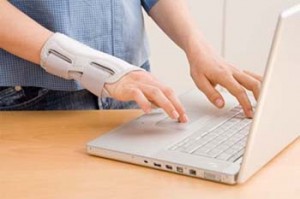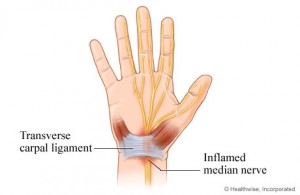Strict Standards: Non-static method Locate_Api_Map::getMetaKey() should not be called statically in /home/uxhbg5d8jpni/public_html/mgwministry/wp-content/themes/churchope/functions.php on line 194

Carpal Tunnel Syndrome
Materials Needed:
- un-dyed cotton cloth

- stainless steel pan
- distilled water
- plastic wrap (such as Saran wrap)
- ace bandage (optional)
Ingredients:
- six parts oak bark
- three parts marshmallow root
- three parts mullein herb
- two parts wormwood
- one part lobelia
- one part skull cap
- six parts comfrey root
- three parts walnut bark or leaves
- three parts gravel root
How to Make:
Make a decoction of the combined herbs in distilled water. Use one pint of distilled water for every ounce of herb used. Soak the herbs for four to six hours, and then simmer for thirty minutes on the stove (be careful not to boil). Strain, and then simmer the liquid to one-half its volume. Example, if you made one gallon of tea, you will simmer it down to two quarts. Soak cloth around wrist and wrap around affected area (usually from the thumb to the elbow). Cover with plastic wrap. Leave overnight. Do this six days a week for as many week needed until relief appears if severe.
Warning: For EXTERNAL use only
The FDA requires the herb companies to put a warning label on any product that has comfrey in it: Warning: External use only. Consuming this product can cause serious liver damage. This product contains Comfrey. Comfrey contains pyrrolizidine alkaloids, which may cause serious illness or death. This product should not be taken orally, used as a suppository, or applied to broken skin. For futher information contact the FDA at http://www.cfsan.fda.gov
Helpful Tips:
- Parts refer to weight measurements (not volume! use a scale if necessary). For example, one part could equal 1 ounce or even 1 pound.
- This treatment is also effective for other bone and muscle aches and pains such as lower back pain.
- Turn the fomentation into an “icy-hot” treament by alternating the use of heat and cold to the affected area on top of your fomentation. A good rule of thumb is to first apply heat to the area for 12 minutes using either a hot water bottle or a heating pad. Then apply cold using an ice-pack for 4 minutes. Heat and cold can be applied for more or less time depending on the comfort level of the patient.
- Wrap an ace bandage over the plastic wrap if you need to go to work and don’t want to look strange because you have your arm wrapped in plastic wrap!
- Can use with a cayenne pepper extract to bring blood to the affected area and bring additional relief.
- Don’t want to deal with putting together all of the herbs? This herbal combination may be purchased in bulk by clicking here. We are not affiliated in anyway with this vendor, just providing the information for your convenience
What is carpal tunnel syndrome?
The carpal tunnel is a narrow space in the wrist. It contains wrist bones and a ligament (transverse carpal ligament) across the wrist where the palm and forearm meet. Tendons and the median nerve pass through this space to your hand. The median nerve supplies feeling and some movement to part of the hand. The median nerve controls movement and feeling in your thumb and first three fingers (not your little finger).
Carpal tunnel syndrome is usually caused when an illness or other problem makes the carpal tunnel space too small. This puts pressure on the median nerve and causes pain, tingling, and other symptoms.
What causes carpal tunnel syndrome?
Pressure on the median nerve causes carpal tunnel syndrome. This pressure can come from swelling or anything that makes the carpal tunnel smaller. Things that can lead to carpal tunnel syndrome include:
- Illnesses such as hypothyroidism, rheumatoid arthritis, and diabetes
- Pregnancy
- Obesity
- Making the same hand movements over and over, especially if the wrist is bent down (your hands lower than your wrists), or making the same wrist movements over and over
- Wrist injuries and bone spurs
- Smoking, because it can reduce blood flow to the median nerve
What are the symptoms?
Carpal tunnel syndrome can cause tingling, numbness, weakness, or pain in the fingers or hand. Some people may have pain in their arm between their hand and their elbow. Symptoms most often occur in the thumb, index finger, middle finger, and half of the ring finger. If you have problems with your other fingers but your little finger is fine, this may be a sign that you have carpal tunnel syndrome. A different nerve gives feeling to the little finger. You may first notice symptoms at night. You may be able to get relief by shaking your hand.
How is carpal tunnel syndrome diagnosed?
Your doctor will do a physical exam and ask about your health and activities. You also may have some tests.Your doctor will ask if you have any health problems-such as arthritis,hypothyroidism, or diabetes-or if you are pregnant. He or she will ask if you recently hurt your wrist, arm, or neck. Your doctor will want to know about your daily routine and any recent activities that could have hurt your wrist. During the exam, your doctor will check the feeling, strength, and appearance of your neck, shoulders, arms, wrists, and hands. Your doctor may suggest tests, such as:
- Blood tests to see if any health problems might be causing your symptoms.
- Nerve testing to find out if the median nerve is working as it should.
How is it treated?
Mild symptoms usually can be treated with home care. The sooner you start treatment, the better your chances of stopping symptoms and preventing long-term damage to the nerve. You can do a few things at home to help your hand and wrist feel better: Stop activities that cause numbness and pain. Rest your wrist longer between activities. Ice your wrist for 10 to 15 minutes 1 or 2 times an hour. Wear a wrist splint at night to keep your wrist in a neutral position. This takes pressure off your median nerve. Your wrist is in a neutral position when it is straight or only slightly bent. Holding a glass of water is an example of your wrist in a neutral position.

